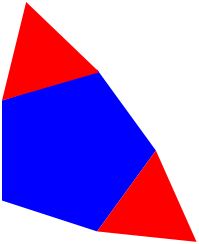Skip over navigation

Or search by topic
Number and algebra
Geometry and measure
Probability and statistics
Working mathematically
Advanced mathematics
For younger learners
What's Happening?
Age 5 to 7
Challenge Level 





- Problem
- Getting Started
- Student Solutions
- Teachers' Resources
What's Happening?

We started with this pentagon.
Added a triangle:

Then another one:

What would come next, and why?
Can you invent something like these for your friends to solve?
Why do this problem?
This activity can be useful for pupils to puzzle out what hidden rules produce the pictures. It gives an opportunity for pupils to share their thoughts and reasoning about how the shapes differ. This skill is important in our theme this month which is coding. Children need to be able to identify rules and patterns from data in order to be able to
decode a piece of text so this task gives them practice in finding and describing these patterns and rules.
Possible approach
It would be good to have large card versions of shapes for groups of children to sit round and discuss the things they notice about them. The children can then start to make the shapes that they predict will follow. Sharing these will enable the pupils to express clearly what they see is the "rule" that is taking place between the shapes.
Key questions
Tell me about the shapes you think come next.
Why have you chosen this shape?
Why does it go there?
Can you describe a rule that explains what you are doing each time?
Possible support
Some pupils may need help in saying what they think as well as listening to others and thinking about what others have said.
You may also like
Biscuit Decorations
Andrew decorated 20 biscuits to take to a party. He lined them up and put icing on every second biscuit and different decorations on other biscuits. How many biscuits weren't decorated?

